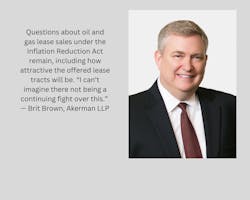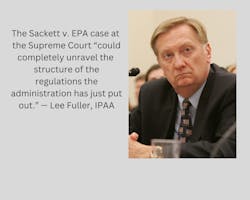Regulatory, court disputes await oil and gas industry in 2023
The center of gravity for federal actions affecting the oil and gas industry can be expected to shift in 2023 now that Congress is divided and the political parties are able to block each other’s legislation. Regulators and courts, already important, can be expected to become more important.
For oil and gas companies, that may mean a sigh of relief, given how 2022 went, with legislation increasing royalties and fees for work on federal lands.
Actions by the Biden administration are generally expected to increase the companies’ obligations under the National Environmental Policy Act (NEPA) and the Clean Air Act and add to the financial challenges faced especially by smaller oil and gas producers, according to specialists who spoke to Oil & Gas Journal. The legal uncertainties of the Clean Water Act also are a concern and the US Supreme Court may be poised to revamp that issue significantly.
Not that industry representatives are giving up on Congress. They say they will seek permitting reform through legislation while continuing to work with regulators on impending changes.
Legislation, maybe
Sen. Joe Manchin (D-W.Va.) tried to negotiate a modest package of permitting reforms in 2022 with special attention to the proposed Mountain Valley Pipeline to carry natural gas from West Virginia to markets. He met bipartisan opposition, from Republicans who felt his reforms were too slight and Democrats who felt they went too far.
“I will not give up,” Manchin said Dec. 15 as his permitting reforms went down to defeat.
Manchin chairs the Senate Energy and Natural Resources Committee, where it is possible permitting reform in 2023 could be voted out of the committee with Republican support plus Manchin’s vote. Opposition from the left wing of the Democratic Party in the House no longer can stop such legislation now that Republicans are the House majority.
Manchin has not said what legislation he might have in mind for 2023, but whatever it is, it may face the same problem as last year—Senate Democrats who counsel restraint, backed up by President Biden’s veto authority, and Republicans who want serious NEPA changes.
“The environmentalists will try to turn this into a fossil fuel fight,” Naatz said, but “it’s so much more than that.”
NEPA regulations and litigation are “hugely important to our members” and a drain on the economy, he said.
The American Gas Association (AGA) and the American Petroleum Institute (API) see permitting reform by Congress as a big issue for them to advocate in 2023. Karen Harbert, AGA president, stressed the idea of a time-bound NEPA process limited to 2 years for environmental analysis. Frank Macchiarola, API senior vice-president of policy, economics, and regulatory affairs, said projects involving gas and oil pipelines often take more than 6 years.
The White House Council on Environmental Quality (CEQ) added another layer of complexity to the NEPA issue Jan. 6 when it released a guidance directing regulatory agencies to insist on mitigation measures under NEPA “to the maximum extent possible” to limit greenhouse gas (GHG) emissions.
More action is expected from CEQ in the form of rollbacks of Trump administration NEPA guidances that were welcomed by the oil and gas industry.
Supreme Court cases
The Biden EPA essentially reestablished the standards of the Obama EPA, a mixture of generally agreed-upon details plus the idea—not at all agreed upon—that isolated water bodies and wetlands are jurisdictional if agencies determine there is a “significant nexus” between those features and the accepted jurisdictional “waters of the United States,” commonly referred to as WOTUS.
But a pending US Supreme Court decision “could completely unravel the structure of the regulations the administration has just put out,” said Lee Fuller, IPAA environmental and general strategy officer.
The Sackett v. EPA case at the Supreme Court is an important issue in terms of the numbers of people and industries affected, said Brit Brown, chair of the energy sector team at the Akerman LLP law firm.
Brown said many people think the Supreme Court will issue a ruling establishing the jurisdictional model proposed in 2006 by Justice Antonin Scalia. In the Rapanos case, Scalia argued that water bodies should be judged jurisdictional if they have a continuous surface water connection to accepted jurisdictional waters, and wetlands should be jurisdictional if they are adjacent to those waters. That would leave out isolated ponds and wetlands, and Scalia’s model also would leave out ephemeral waters, which only hold water after a rain and most of the time are dry spots.
Brown said he thinks criticisms of the “significant nexus” test for lack of clarity are valid and that the Supreme Court probably will rule in favor of the plaintiffs in the Sackett case. “You would think that they will go with the Scalia model,” Brown said.
WOTUS is not the only notable case at the Supreme Court this year. In December, the court gave Exxon Mobil Corp., DCOR LLC, and the American Petroleum Institute until Jan. 25 to file a petition for an appeal of a decision halting Interior Department approvals of well stimulation techniques including hydraulic fracturing in federal waters off the West Coast.
The US Court of Appeals for the Ninth Circuit ruled June 3 that an environmental assessment for offshore well stimulation was inadequate under NEPA and required a much more extensive analysis before more such operations could be approved. The court also ruled that Interior’s agencies must do more analysis under the Coastal Zone Management Act. The case was Environmental Defense Center v. Bureau of Ocean Energy Management.
Air emissions controls
EPA has indicated it will issue in 2023 its final new rule for control of methane and related emissions from oil and gas production, storage, and pipeline transportation. Fuller said the agency may try to get the rule out as early as June.
There also will be a 3-year phase-in for existing sources, as distinct from new sources.
An especially difficult issue is the application of tougher standards to smaller producers. The US in 2021 had more than 916,000 producing oil and gas wells, of which 80% or about 732,000 produced less than 15 boe/d, according to the Energy Information Administration. Operators may not be able to justify the cost of new emission controls when measured against the modest revenues of such wells. A great many such wells could be shut down.
“It almost seems like that’s an intention,” said Benjamin Escobar, an Akerman trial lawyer with much experience in energy. He cautioned, “It’s not an express intention.”
Escobar said the Supreme Court recently has been showing more concern for the “major questions doctrine,” a legal doctrine that says Congress should settle the larger questions rather than leaving them to courts. “I could see some organization wanting to take a shot at challenging the new methane rule” under the major questions doctrine, he said, though he expressed doubt about that strategy.
It will be a significant loss of oil and gas volumes in aggregate if the old, small wells shut down, Escobar’s colleague Brown said.
Onshore, offshore leasing
Biden ordered a moratorium on new lease sales when he took office in 2021, but litigation and the compromises written into last year’s budget bill—the Inflation Reduction Act—have forced a resumption of lease sales both onshore and offshore.
The act includes stipulations requiring oil and gas lease sales if the government wants wind farm lease sales. It also imposes higher royalty rates and higher fees. Many questions about future lease sales remain to be answered, including how attractive the offered lease tracts will be. The Bureau of Land Management will not necessarily offer what companies want to lease.
“I can’t imagine there not being a continuing fight over this,” Brown said of the leasing.
The higher royalties and fees will have some effect on bidding, but it remains to be seen how extensive the impact will be, said IPAA’s Naatz.
The potential impacts of federal costs and restrictions seem to worry some lawmakers, not others. Newly elected Rep. Mary Peltola (D-Alas.) is acutely conscious of her home state Alaska’s dependence on oil revenues. Oil accounts for 80% of state government revenues, she recently said. The congressional delegation of New Mexico expresses no concern about regulatory costs and restrictions for fossil fuels. Yet about 40% of New Mexico’s budget depends on oil and gas royalties and fees.
The Bureau of Ocean Energy Management (BOEM) is obligated to come up with a new 5-year plan for leasing of oil and gas exploration tracts in federal offshore waters. How long BOEM will take is anybody’s guess. BOEM is required to hold two offshore oil and gas lease sales in 2023, but it does not face a strict deadline for the 5-year plan.
SEC, CPSC, FERC
Companies increasingly face demands for more attention to environmental, social, and governance (ESG) issues. In operations, it can mean such details as the use of more electrical power rather than diesel fuel to drive drilling rigs. The bigger problem comes in finance, including worries about what investors think.
The Securities and Exchange Commission has not yet completed a rule to mandate enhanced and standardized corporate reporting of climate change risks and greenhouse gas emissions. It also has not yet finalized a rule to standardize reporting of ESG factors. The climate rule was proposed in March 2022 and the ESG rule followed in May. Both rules raise the possibility of rhetoric that worries investors and leads to fights over the correctness of reporting.
A Biden appointee on the Consumer Product Safety Commission (CPSC) in early January caused commotion over the idea that the commission might propose a ban on new stoves that use natural gas. That apparently is unlikely. The CPSC and its chairman quickly backpedaled, while saying the commission continues to look for ways to make appliances safer.
And the Federal Energy Regulatory Commission (FERC) is in need of a new member. Former Chairman Richard Glick left office in early January, and Willie Phillips became acting chairman. The commission, now with four members, runs the risk of tie votes, although it has accomplished much in the past without the full complement of five members. Biden has not yet nominated a new commissioner.
About the Author
Alan Kovski
Washington Correspondent
Alan Kovski worked as OGJ's Washington Correspondent from 2019 through 2023.





